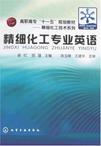精细化工专业英语
出版时间:2008-8 出版社:化学工业 作者:吴红 页数:159
Tag标签:无
内容概要
本书由全国化工高职教学指导委员会精细化工专业委员会组织编写,书中选材难易适中,内容覆盖面宽,全书共分5章,包括精细化工简介、精细化工产品介绍、单元反应、单元操作、工厂典型设备。每章含有课文正文、词组、难点注释、理解练习、阅读材料等部分,内容上循序渐进,遵循学生的认知规律。 本书可作为高职高专化学、化工及相关专业的教材,也可供有关厂矿企业技术人员参考。
书籍目录
Part 1 Introduction Lesson1 The Characteristics of English for Science and Technology Lesson2 Word?Building of English for Science and Technology Lesson3 A Brief Introduction of Fine ChemicalsPart 2 An Outline of Some Fine Chemicals Lesson4 Surfactants Lesson5 Different Types of Surfactants Lesson6 Adhesives Lesson7 Plasticizers Lesson8 Heat Stabilizers Lesson9 Food additives Lesson10 Dyes Lesson11 Paints Lesson12 Chemical Insecticides and Biological Insecticides Lesson13 The History and Health Effect of Herbicide Lesson14 Discovery of Sulfa Drugs Lesson15 Shampoos Lesson16 Heterogeneous Catalysts and Homogeneous Catalysts Lesson17 Types and Importance of CatalystsPart 3 Unit Reaction Technique Lesson18 Radical Halogenation of Methane Lesson19 Sulfonation of Benzene Lesson20 Synthesis of Esters Lesson21 Oxidation of Alcoho Lesson22 Alcohols by Reduction of Carbonyl CompoundsPart 4 Unit Operation Lesson23 Distillation Lesson24 Drying Lesson25 Liquid Extraction Lesson26 Size Reduction and Mixing Lesson27 Adsorption Lesson28 Supercritical Fluid ExtractionPart 5 Typical Equipments in Plants Lesson29 Reactor Lesson30 Filters and Centrifuges Lesson31 Driers Lesson32 Extractors Lesson33 EvaporatorsAppendixAppendix1 Common Glassware NamesAppendix2 Common Prefix and SuffixAppendix3 Common Chemical Prefix and SuffixAppendix4Name and Symbols of Elements参考文献
章节摘录
Part 1 Introduction Lesson 1 The Characteristics of English for Science and Technology 为了学习和了解国外先进的科学技术,增强国际科技交流能力,人们需要学习和研究大量国外的科技文章,但目前仍有不少人无法直接阅读外文文章,这就使得科技翻译越来越受到人们的重视。科技翻译为各民族的科技交流活动起到桥梁和纽带的作用。“翻译是一间屋子的窗户,它可以放进新鲜空气,并可以让我们看到外面的一切。”因此了解并掌握科技英语的特点,对于阅读、翻译或撰写英文文献有着十分重要的作用。 科技英语是描述科技内容的英语,在词汇方面同基础英语没有绝对的界限,但科技英语作为一种特殊的文体,在用词方面有其自身特有的形成和构成特点。除了一些专门术语外,科技英语中使用的词语,大多属于正式书面语体的范畴。正式书面语的采用,有利于提高科技文章的正规性。另外,科技英语词汇在其形成过程中也充分运用英语构词法,利用现有的语言材料,采用借用、组合、转换等构词方法来表达新的含义,因此,科技翻译工作者需要了解科技英语的特点,从而正确表达。 一、大量使用名词化结构 《当代英语语法》(A Grammar of Contemporary)在论述科技英语时提出,大量使用名词化结构(nominalization)是科技英语的特点之一。因为科技文体要求行文简洁、表达客观、内容确切、信息量大,强调存在的事实而非某一行为。 e.g.1 Archimedes first discovered the principle of displacement of water by solid bodies. 阿基米德最先发现固体排水的原理。 句中of displacement of water by solid bodies系名词化结构,一方面简化了同位语从句,另一方面强调displacement这一事实。 e.g.2 If you use firebricks round the walls of the boiler,the heat loss can be considerably reduced。
图书封面
图书标签Tags
无
评论、评分、阅读与下载
用户评论 (总计2条)
- 内容编排有点像阅读理解~~~
- 拆开袋子的时候,发现一张纸掉了,书本质量很差,内容也很简单
推荐图书
- Web数据库技术应用教程
- 计算机网络互联与测试
- Information Theory & Coding信息论与编码
- C语言程序设计实训
- 城市洪水风险管理与灾害补偿研究
- 新概念英语词汇录音多模式跟读训练 3
- 长江三峡工程围堰蓄水期
- 挑战大学英语四级考试1688高频核心词汇
- 自动控制理论
- 四级英语关键词循环速记手抄本
- 雅思考试关键词循环速记手抄本
- 专八英语关键词循环速记手抄本
- 洪家渡水电站工程设计创新技术与应用
- 建筑材料学
- 中考英语关键词循环速记手抄本
- 高考英语关键词循环速记手抄本
- 心力衰竭
- 慢性肾功能衰竭诊断与中医治疗
- 主动防范常见病
- 护理论文写作技巧
- 产科超声检查
- 停住时间的脚步
- 肿瘤综合诊疗新进展
- 美国的法律实用主义
- 立法主权与近代国家的建构
